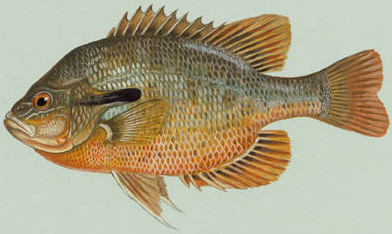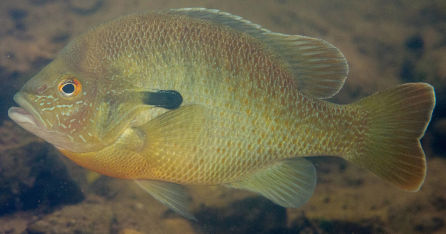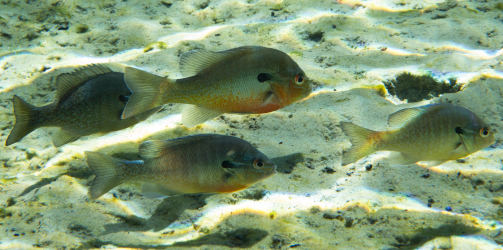Redbreast Sunfish (Lepomis auritus)


The redbreast sunfish is a freshwater fish in both the sunfish family Centrarchidae and the true sunfish genus Lepomis. Lepomis includes the green sunfish, pumpkinseed, warmouth, orangespotted sunfish, bluegill, dollar sunfish, longear sunfish, redear sunfish, redspotted sunfish, northern sunfish, spotted sunfish, and bantam sunfish. Lepomis meaning scaled lid / cover, auritus meaning long ear, both referring to the operculum / gill cover.
Where to Find Redbreast
The native range consists of the eastern United States coast on the eastern slope of the Appalachian mountains. Uncommon fish species for stocking or aquaculture efforts, likely to just find in streams and rivers.
Redbreast can be found throughout the entire water column but due to their preference for hiding among rocks and logs, starting low can be productive. They are opportunistic feeders like other sunfish but their larger mouth lets them feed on a larger variety of prey, which leads them to spend time in slightly different areas than other sunfish. When they are not in shallow water spawning areas best bet is to check deeper, slower, pools with cover like rocks, logs, or vegetation.

Other Names for Redbreast
Other names people have used to refer to this fish include yellowbreast, yellowbelly, long eared sunfish, robin, red perch, red-headed bream, and bream.
When to Fish For Redbreast
Most productive times are when water temps are > 50F. Late spring to summer can be found near shallow water spawning areas. You can technically fish for them in the winter, but hard to target as they will be extremely tight to structure. Due to their habitat preferences, not as likely a catch ice fishing as say a bluegill or pumpkinseed.
- Common Less than half pound
- Trophy 0.75 lb plus
- Record 1.25 lb plus
Diet of Redbreast
The redbreast sunfish is a generalist, omnivorous, opportunistic feeder largely consuming aquatic invertebrates such as chironomids (lake flies) and as they grow larger expanding to larger food items like terrestrial invertebrates, fish, and crayfish.
When redbreast are feeding on small aquatic invertebrates this would include chironomids (lake flies), ceratopogonids (biting midges), cladocera (water fleas), and various copepods. Some of the larger prey redbreasts can eat include snails, beetles, crayfish, and fish (baby sunfish, shiners, etc).
The large variety of possible food items includes seeds, detritus, mussels, mayflies, caddisflies, water mites, dragonflies, ants, isopods, true bugs, worms, short-tail shrew, spiders, fish eggs, and stoneflies.
- Common Less than 6 inches
- Trophy 9 inches plus
- Record 12 inches plus
What Tackle to Use For Redbreast
Redbreast sunfish will readily take to most styles of lures or baits. Since they have a large mouth, can use a variety of panfish and trout tackle.
Recommended lure and jig head is the Trout Magnet.
Recommended artificial baits: Crappie Nibbles, Honey Worms, Floating Trout Worm, or Angle Worms
Recommended grocery store baits: corn, bread or marshmallows.
Cooking and Eating Redbreast
Redbreast are a good eating fish and they are very similar to bluegill and other sunfish in terms of eating, taste, and cooking. Anything you have read for recipes or taste for bluegill should also apply for redbreast. Their body shape is slightly different from other sunfish like bluegill and pumpkinseed but that is the only major difference. A popular way to cook them is to fry them whole and enjoy them like you would fried chicken. If you fry them whole, the fins and smaller bones can also be eaten and provide a satisfying crunch. Redbreast can also be filleted and you can cook the boneless portions of meat however you wish. However, given that redbreast tend to be on the smaller side and due to their body shape, filleting can waste some meat.
